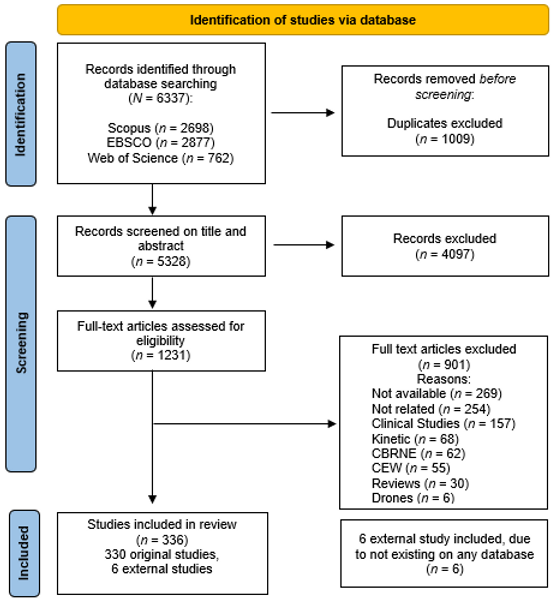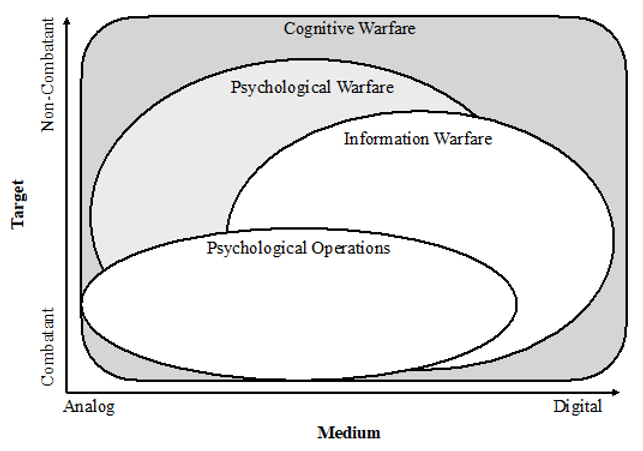Abstract: The human mind is the paramount battleground in modern warfare, where cognitive warfare emerges as an unparalleled domain demanding recognition. The People’s Republic of China and Russia have incorporated cognitive warfare and related strategies into their operations. However, there remains a blurriness regarding the concept and application of cognitive warfare in academic discourse and Western military doctrines.
Problem statement: How to define cognitive warfare from a psychological perspective to adapt to the changing landscape of modern combat?
So what?: Nations and international alliances must adjust their doctrines to have a uniform and comprehensive definitory landscape. Simultaneously, these actors must educate and train staff in the correct terminology to ensure interoperability and intelligibility.

Cognitive Warfare, the Pinnacle of Modern Warfare
The human psyche has emerged as a paramount factor in military operations in the past century. Cognitive warfare and the associated fight for cognitive superiority has become a central battlefield in modern warfare and is best described as a strategy that focuses on “altering through information means how a target population thinks, and through that, how they act”.[1], [2], [3], [4], [5]
In retrospect, the concepts of cognitive warfare, cognitive superiority, and their associated terminology still retain a developing status in the academic and military discourse. Only as recently as 2017 did the U.S. Department of Defense formally acknowledge human cognitive attributes (knowledge, understanding, beliefs, and world views) as one of three dimensions of the Information Environment (IE).[6] Subsequently, scholars increasingly incorporated ‘Cognitive Warfare’ and ‘Cognitive Superiority’ into their academic and military works.[7], [8], [9] NATO also became actively engaged with these terms in 2021, following their inaugural scientific meeting regarding cognitive warfare. A universally accepted definition for the term ‘Cognitive Warfare’ remains elusive, which poses a significant obstacle to achieving a comprehensive understanding of, and effectively working with, this concept and its associated terminology.[10]
The concepts of cognitive warfare, cognitive superiority, and their associated terminology still retain a developing status in the academic and military discourse.
The significance of cognitive warfare is also evident when viewed through a historical lens. As far back as 2070 BC, Chinese military strategists recognised the pivotal role of psychology in military strategy. They referred to this aspect as the ‘war of attacking the heart’. From a contemporary standpoint, Sun Tzu was one of the most seminal Chinese military strategists.[11] In his book ‘The Art of War,’ Sun Tzu provided profound insights that remain relevant and are arguably even more crucial in modern warfare.[12], [13], [14], [15] “All warfare is based on deception.”[16]
These historical insights trace the traditional origins of cognitive warfare, encompassed within the broader framework of ‘Psychological Warfare.’ The initial academic emergence of these ideas occurred in 1920, credited to J.F.C. Fuller. In his analysis of the First World War, Fuller coined the term ‘Psychological Warfare.’ He went on to foresee a transformative shift, envisioning a future where the conventional methods of warfare might be supplanted by a form of warfare purely psychological in nature. In this hypothetical scenario, traditional weapons and battlefield confrontations would give way to a different kind of warfare – one that seeks not to employ arms or seize territories but rather to manipulate the human intellect and disrupt the moral and spiritual foundations of a nation through the influence wielded by another to ultimately ensure triumph with minimal losses.[17] The term ‘Psychological Warfare’ has been employed in various ways since its initial academic introduction by Fuller in 1920. Presently, the terms ‘Psychological Warfare’ and ‘Cognitive Warfare’ remain closely interconnected, demanding a precise and distinctive definition to facilitate coherent comprehension and focused research endeavours. This conceptual ambiguity presents a hurdle in comprehensively understanding cognitive warfare and its related terminologies.
Therefore, it is essential to understand whether cognitive warfare can be regarded as the evolutionary successor to the historical concept of psychological warfare. The modernisation of techniques, driven by advancements in technology such as social media, has transformed traditional methods like leafleting. Upon closer scrutiny of the definitions, it becomes apparent that there is a substantial overlap, facilitating the conclusive amalgamation of these terms into the overarching concept of cognitive warfare. Additionally, it is necessary to analyse whether terms such as psychological operations and information warfare can be encompassed within the broader framework of cognitive warfare, serving as distinct practical actions of cognitive warfare strategies.
The modernisation of techniques, driven by advancements in technology such as social media, has transformed traditional methods like leafleting.
Literature searches were performed using the following databases:
- EBSCO (eBook Collection, Psychology and Behavioral Sciences Collection, APA PsycInfo, PSYNDEX Literature with PSYNDEX Tests, SocINDEX with Full Text);
- Scopus; and
- Web of Science.
The search was conducted from 05/23/2023 to 07/20/2023, with the final search occurring on 07/20/2023. The literature review results are reported according to the PRISMA guidelines (Preferred Reporting Items for Systematic Reviews).
Inclusion Criteria
The paper must have one of the following themes:
- Civil-military theme, Politic-military theme, Historic-military theme, State-military theme;
- It must contain one of the following keywords: Psychological Warfare, (Cyber-) Cognitive Warfare, Information Warfare, Hybrid Warfare, Digital Warfare, Cyber Warfare, Psychological Operations, Information Operations, Propaganda;
- It must be a scientific publication or military/government document;
- It must be written in the English or German language; and
- The full text must be available.
Exclusion Criteria
- Clinical studies;
- CBRN-associated studies (i.e., Bioterrorism, Nuclear, or Chemical);
- Traditional warfare studies based on kinetic force; and
- Cognitive electronic warfare.

Descriptive Definitions of Cognitive Warfare
Lasswell’s model of communications serves as a good framework for comparing the definitions of cognitive and psychological warfare because this model offers a well-defined pathway for understanding communication: Who (the communicator) conveys what (the message) through which channel (the medium) to whom (the receiver), resulting in what effect (the effect). An additional component, the when (the state of warfare), was introduced to clarify the contextual conditions in which cognitive warfare strategies are employed and enhance the model’s applicability to cognitive warfare. Thus, for this paper, these six core elements, including the added state factor, represent the key components of the communication process.
Originally crafted for analysing mass communication mediums, Laswell’s model was chosen for its simplicity, transparency, and adaptability, making it particularly suitable for a broad comparative examination of definitions. Consistent with this model, essential aspects of cognitive warfare were distilled, serving as the foundational elements of the comprehensive definition of cognitive warfare.[18]
Who (Communicator)
The specific identity of the communicator in cognitive warfare measures remains elusive. Typically, these measures can be instigated by virtually anyone, owing to technological advancements and the widespread availability of technology with a broad spectrum of potential consequences (e.g., spreading unverified facts or data, using false identities, distorting information through decontextualization, etc.). Nevertheless, the primary focus should be on military personnel or state actors. In three analysed papers, the communicator is referred to as either an attacking state/non-state actor or an influence group.
The specific identity of the communicator in cognitive warfare measures remains elusive.
What (Message)
The message typically encompasses a comprehensive strategy involving the utilisation and distribution of information, which includes information operations and manipulated information like misinformation, disinformation, and propaganda. These methods primarily fall under non-kinetic actions, meaning they do not involve physical impacts like artillery fire or bullets. However, they can complement or integrate with kinetic measures to compel or strengthen cognitive and behavioural alterations.[19]
Which (Medium)
Cognitive warfare measures are disseminated through predominantly technological means, spanning online platforms (e.g., internet, social media networks) and offline channels (such as TV broadcasts, radio, leaflets, and word of mouth).
Whom (Receiver)
The target audience of cognitive warfare measures remains largely undefined. These measures can potentially encompass a wide spectrum of recipients within society, including specific groups or individuals, entire nations, opposing parties, or the enemy or enemy forces in general.
What (Effect)
Cognitive warfare measures aim to achieve specific outcomes by affecting various cognitive processes, including perceptions, values, beliefs, culture, and knowledge. This influence on cognitive processes serves as a crucial precursor to the ultimate objective of altering or disrupting the target audience’s behaviour. Notably, these changes or disruptions in behaviour may pertain to decision-making, public opinion, situational awareness, and trust. The desired effect seeks to realise predetermined objectives and/or gain an advantage over an adversary.
Cognitive warfare measures aim to achieve specific outcomes by affecting various cognitive processes, including perceptions, values, beliefs, culture, and knowledge.
When (State)
Cognitive warfare measures are not confined to any specific timeframe. They can be employed in peace and at any stage during a conflict. Following the extraction of key elements of cognitive warfare, a definition of cognitive warfare is proposed as follows:
Cognitive warfare is the deliberate dissemination of information, utilising both digital and analogue mediums, orchestrated by unidentified actors to destabilise and influence the cognitive processes and behaviours of unspecified recipients in times of conflict and peace.
Descriptive Definitions of Psychological Warfare
In examining the concept of psychological warfare, Lasswell’s Model of Communication was similarly employed to underscore key definitional components.
Who (Communicator)
Most publications regarding psychological warfare typically do not provide a specific definition for the communicator. However, in four studies, the communicator is explicitly identified as a nation or state.[20], [21]
What (Message)
The overarching techniques constituting Psychological Warfare encompass various communication strategies, including tactics such as deception, both overt and covert news dissemination, propagation of rumours, rational publicity, the deterrence of will, and emotional influence.[22], [23], [24], [25], [26], [27], [28] Additionally, deliberate manipulation of information is a key component involving the planned utilisation of propaganda, psychological operations, disinformation, or information denial.[29], [30], [31], [32] Overall, these methods aim to psychologically destabilise and polarise the target population.[33], [34]
Which (Medium)
Traditionally, psychological warfare measures are predominantly distributed by offline mediums (e.g., leaflets, loudspeakers, radio broadcasts, television or some other mediated method, or political action). Currently, social media and internet communication are also increasingly used to distribute psychological warfare measures (e.g., mass media publications policy and corresponding interned media policy; modern communication technology), mainly due to the fast advancements in media technology.
Social media and internet communication are also increasingly used to distribute psychological warfare measures, mainly due to the fast advancements in media technology.
Whom (Receiver)
The intended recipients of psychological warfare measures are primarily framed as ‘the enemy.’ However, like cognitive warfare, the target audience is often undefined. This implies that individuals across various strata of society, encompassing leaders, decision-makers, specific groups like nations, opposing factions, neutral states, the global community, and governmental entities, all have the potential to be targeted recipients of these measures.[35], [36], [37], [38], [39], [40], [41], [42], [43], [44], [45] Furthermore, it is noteworthy that psychological warfare measures have been reported to be employed on communicators’ own troops and domestic populations as well.[46]
What (Effect)
The desired effects of psychological warfare measures resemble those of cognitive warfare. Three central effects were identified:
- Influencing the enemy´s cognitive processes (e.g., emotions, judgements, thoughts, opinions, attitudes, reasoning, values, beliefs, perceptions, morale, personal insecurity, destabilisation and polarisation, as well as promoting distrust);
- Influencing the enemy´s behaviour (e.g., decision-making, complacency, surrender, dissent within ranks, reducing the authority of the government, shaping public opinion, etc.);[47]
- Influencing own cognitive processes and behaviours (e.g., build up morale within own side, encourage resistance, obtain sympathy and support).
Generally, these effects aim to achieve a predetermined desired goal or an advantage on the national, political, or military level, whichever is advantageous to the attacking nation. This bolsters current policies, advances military or national objectives, and may create favourable conditions.
When (State)
Authors often contextualise the utilisation of psychological warfare measures with wartime scenarios, albeit these measures are not limited to them. These measures are also commonly employed during peacetime.
The utilisation of psychological warfare measures is often contextualised with wartime scenarios, albeit these measures are not limited to them.
After extracting key components of psychological warfare according to Lasswell’s Model of Communication, a definition of psychological warfare is proposed:
Psychological warfare is the deliberate utilisation of communication strategies, encompassing both online and offline mediums, orchestrated by predominantly anonymous actors to manipulate and destabilise primarily unspecified recipients, both in times of warfare and peace.
Examining the Overlap of the Two Descriptive Definitions
By isolating essential components from both definitions using Lasswell’s communication model and formulating descriptive definitions, it becomes feasible to make comparisons between them.

Examining the table above exposes a considerable convergence between the two definitions. The main distinctions reside in the wording of specific terms. For instance, in the “What (Message)” component, the term ‘information’ has gained prominence, particularly with the advent of technology and media, especially social media. Earlier, ‘communications’ was a more common descriptor for this phenomenon. Similarly, differences in the distribution of measures (Medium) are evident. In its earlier origins, psychological warfare relied more on offline distribution methods due to the absence of today’s wide-reaching technology. In contrast, the impact and reach of online measures today render offline measures almost obsolete. This shift is a result of the evolution of technology and circumstances.
When considering the “Receiver” component, the extracted information of both cognitive and psychological warfare closely resemble each other, with the minor distinction that psychological warfare definitions more frequently frame the receiver as an ‘enemy’ compared to cognitive warfare definitions. This disparity can be attributed to temporal and policy distinctions, as nations tend to exercise caution in designating their opponents as ‘enemies’ and their military operations as ‘wars,’ primarily due to the terms’ legal and political consequences. These implications also underlie the rationale for excluding one’s population or troops as target audiences in cognitive warfare approaches, although many definitions include this factor.
When considering the “Receiver” component, the extracted information of both cognitive and psychological warfare closely resemble each other.
Thus, after extracting essential components, it becomes evident that both concepts are nearly identical. The key differences herein underscore the impact of technological advancements, greatly expanding the range of potential attacks, often making them undetectable or difficult to attribute to a specific communicator in the contemporary world. Consequently, cognitive warfare should be recognised as the evolution and modernisation of psychological warfare. Hence, it should be addressed and utilised as such in modern literature, eliminating ambiguity surrounding the terminology. As succinctly articulated by Yun & Kim in their publication:
“Cognitive Warfare is a more expanded concept of psychological warfare. Psychological warfare focuses on the perceptions, thoughts, and feelings of human agents to affect the psychology of human actors. Cognitive warfare is a concept that has evolved a step beyond psychological warfare, focusing on the occupation of human cognition to ultimately impact human acts.”
Embedding Associated Measures Under the Term “Cognitive Warfare”
Psychological Operations
The initial use of the term ‘psychological operation’ can be attributed to U.S. Navy Captain (later Rear Admiral) Ellis M. Zacharis, who employed it to expedite Japan’s surrender. Subsequently, in 2010, the U.S. Secretary of Defense substituted ‘psychological operation’ with the term “Military Information Support Operations,” due to the perceived negative connotations associated with the former. These operations, whether referred to as ‘psychological operations’ or ‘Military Information Support Operations’ are defined as follows:
Department of Defense (DoD): ‘planned operations to convey selected information and indicators to foreign audiences to influence their emotions, motives, objective reasoning, and ultimately, the behaviour of foreign governments, organisations, groups, and individuals. […] The purpose of psychological operations is to induce or to reinforce foreign attitudes and behaviour favourable to the originators’ objectives.’
Psychological operations can be further differentiated regarding the source of information in white, grey, and black products:
- […] By “white”, I mean activity which is openly sponsored by one’s government…”
- […] to conduct “grey” activities, attributing information originally disseminated by the U.S. Government to third parties.”
- Black propaganda, which involved assigning the source of misinformation to an adversary…”[48]
This differentiation allows Bernal et al., (2021) to draw a distinction between psychological operations and cognitive warfare. They assert that cognitive warfare predominantly deals with grey products because white and black products are either “too transparent or too risky to be reliable methods of affecting public opinion.” They also note a “certain element of deniability inherent to Cognitive Warfare that is lost in white products and endangered in black products.” While this technical distinction holds, these statements disregard the fact that technological advancements, such as social media, have amplified the effectiveness of grey products. This leads to increased confusion regarding the communicator or the source of information, diminishing the effectiveness or value of using white and black products. Additionally, more non-state actors and influence groups employ cognitive warfare measures, which tend to compound the confusion by disseminating information as grey products.
More non-state actors and influence groups employ cognitive warfare measures, which tend to compound the confusion by disseminating information as grey products.
Furthermore, Bernal et al. differentiate these terms based on the target audience. They observe that “PsyOps has rarely dealt with large sections of the public. There is an emphasis on military or subversive activity in PsyOps that is not usually the goal of cognitive warfare tactics, which tend to target civilian social infrastructure and government.” While this statement aligns with the idea that psychological operations often frame the receiver as an ‘enemy,’ referencing military conflicts, it’s worth noting that multiple definitions of psychological operations clearly define friendly and neutral audiences as their target audience as well.
Upon reviewing the definitions of psychological operations and considering relevant counterarguments, it becomes evident that the term ‘psychological operations’ can be subsumed into a comprehensive taxonomy under the construct of cognitive warfare.
“Cognitive Warfare […] is the umbrella term which is widely used to describe the basic aspects of today’s psychological operations (PsyOp) as well as Military Information Support Operations (MISO), political warfare, “Hearts and Minds” and propaganda.”
Information Warfare
The concept of information warfare shares a common origin with psychological warfare. Doctrinally, both emerged from the analysis of the First World War by the British historian J. F. C. Fuller in 1920. The term ‘information warfare,’ initially referring to a “special type of Intelligence Special Operations,” was adopted by the U.S. in 1966. Since then, this term and various synonyms, such as Information Psychological and Informational Influence, have found frequent usage in literature, military doctrines, and concepts worldwide.
Nowadays and retrospectively, the most prominent utilisation of the term ‘information warfare’ can be attributed to the Russian military. At the beginning of the new millennium, the Russian military began to differentiate between the Information Technical andthe Information Psychological forms of conflict in the information space.
Information Technical is mostly associated with today’s concept of cyberwarfare:
- “… technical intelligence devices, means and measures for protecting information, super-high-frequency weapons … radio-electronic countermeasures, electromagnetic impulse weapons, and special software and hardware.”
- Whereas Information Psychological refers to a combination of psychological warfare and information warfare:
- “In contrast, Information Psychological was associated with use of the mass media, and with the employment of ‘nonlethal weapons, psychotronic tools, and special pharmaceuticals’.”
- This differentiation has dissolved over the years in Russian doctrine. Since 2010, there has been a shift to the generalisation of both terms under the umbrella term of information warfare:
- “[…] ‘wars are no longer declared and, having begun, proceed according to an unfamiliar template’, describing information ‘warfare’ as an activity that would be conducted in both wartime and peacetime, with a goal of securing ‘national policy objectives’ through influence on an opponent’s information system and ‘psychic conditions,’ via promulgation of disinformation; societal and situational manipulation; ‘crises control’; propaganda efforts directed at effecting ‘conversion, separation, demoralisation, desertion, [and] captivity’; lobbying; and blackmail.”
This was further solidified in the influential speech of the Russian general and chief of the general staff, Valery Gerasimov. He understood that hybrid warfare was at the forefront of modern warfare. The effectiveness of traditional kinetic means was being exceeded by “nonmilitary means of achieving political and strategic goals” by “political, economic, informational, humanitarian, and other nonmilitary measures – applied in coordination with the protest potential of the population.”[49]
This importance and depth of Russian information warfare is being further stressed by other authors like Bolton (2021), deepening the understanding of Russian information warfare doctrine by identifying key components and objectives:
- “[…] Russia envisions additional objectives in line with information-psychological warfare. The first is deep penetration and ‘reflexive control.’ This involves interjecting/highlighting the ‘necessary reasons and motive to the ‘target system,’ distorting facts or imposing ‘emotional impressions’ on those involved in policymaking to influence how decisions are approached. The second is establishing ‘permissive environments’ wherein discourse or debate lines favourable to Moscow permeate a targeted society. Finally, information warfare can undermine a society to increase Moscow’s ‘relative strength in a classic zero-sum approach.’ Again, this is not relegated to times of war or as laying the groundwork for military conflict, with Russia’s interference into the U.S. election falling neatly within this remit.”[50]
In summary, the Russian doctrines offer much insight regarding information warfare’s objectives, targets, and strategies.
“Nevertheless, a more modern definition, drawn from Russian doctrine, defines information warfare (or operations) ‘[as the] conscious employment of information to enable the user to achieve his political, economic, military, or other goals … [to be] conducted constantly, in peacetime, in the period of threats … and in wartime … [by] committing all available forces and software and hardware potentialities to impact the opponent’s information capabilities and protect our own against similar actions by the opponent.’”
Contrary to the Russian framework for information warfare, the U.S. perspective differs significantly from the broader definitions of information warfare and the conceptualisations of adversary nations, such as Russia.[51]
“The current DoD [Department of Defense] term for military information warfare is ´Information Operations´ (IO). DOD information operations are actions taken during times of crisis or conflict to affect adversary information while defending one’s own information systems to achieve or promote specific objectives. The focus of IO is on disrupting or influencing an adversary’s decision-making process.”[52]
The U.S. military considers information warfare, or specifically information operations, as its cornerstone, comprising five operational domains:
“Army IO doctrine […] and joint doctrine describe IO as the integrated employment of the core capabilities of EW [electronic warfare], CNO [computer network operations], PSYOP [psychological operations], military deception, and OPSEC [operational security] in concert with other specified supporting and related activities (such as civil affairs, PA, Combat Camera, and, when appropriate, combat operations). The collective purpose of IO synchronisation is to inform, influence, deter, degrade, deny, or disrupt adversarial human and automated decision making while protecting our own.”[53]
Meanwhile, information warfare is understood as information war in Chinese military doctrine. Information war “refers to a kind of war and war pattern, while information warfare refers to a kind of operation or operational pattern.” This differentiation is underscored by the Chinese doctrine’s perspective that information war is “not limited to ties of conflict or crisis but is ongoing.” In summary, the components of Chinese information warfare can be succinctly encapsulated in the following definition:
“Information warfare is the fight with and for information resources, which occurs on both the physical and mental plane of existence. Its actions and activities occur throughout the entire spectrum of political-military (peacetime, crisis, and wartime) proceedings. In addition, its activities inherently contain an offensive and defensive capability to affect an adversary’s will and capability to initiate and sustain a conflict.”[54]
Apart from these national doctrines, information warfare can generally be defined as follows:
“Information warfare is defined as actions focused on destabilising or manipulating the core information networks of a state or entity in society with the aim to influence the ability and will to project power as well as efforts to counter similar attacks by an opposing entity and/or state.”[55]
The Chinese and Russian military concepts of information warfare, as well as the general definitions of information warfare closely align with the previously established definition of cognitive warfare. They share essential components, such as the utilisation of information, targeting a mostly unspecified but predetermined audience across the entire spectrum, unrestricted by time, all to influence cognitive and behavioural processes to attain specific objectives.
Furthermore, several scholars, including Reding & Wells and Hung & Hung, challenge the U.S. conceptualisation of information warfare. They argue that cognitive warfare should be seen as an extension or generalisation of information warfare rather than a component of it, which reaches beyond the battlefield, focusing not explicitly on media control but brain control. Horban identifies key components of psychological warfare and concludes that central ideas associated with psychological warfare, such as mass manipulation and the influence of cognitive processes and behaviours, are present in information warfare.[56]
These conclusions suggest that information warfare or information operations can be subsumed under the term Cognitive Warfare and deployed as a tool within this broader framework.
Conclusion
Cognitive warfare could be identified as a historical descendant of the term psychological warfare. This is shown by comparing several descriptive definitions of the terms using Lasswell’s communication model. Subsequently, a psychological definition of both cognitive warfare and psychological warfare could be derived. Moreover, the terms psychological operations and information warfare are also considered to be subsumed under the term cognitive warfare.
Cognitive warfare could be identified as a historical descendant of the term psychological warfare.

A precise definition and coherent utilisation of constructs are foundational prerequisites for research and practical applications. Distinct and generally conceded definitions facilitate the accumulation of research findings that can mutually reinforce one another and prevent semantic ambiguities in discussions, developments, and operational implementations. Therefore, forthcoming policy and military documents must establish a coherent taxonomy for the terms under consideration to ensure semantic alignment among policymakers, military personnel, and scholars.
Dr. Fabio Ibrahim is a research associate officer at Helmut-Schmidt University in Hamburg, Germany. His research interests include military psychology, psychometrics, and social network analysis. He works with specialised forces of the German Armed Forces and police in aptitude diagnostics and stress management. He is motivated to share scientific findings from psychology in the form of personnel development measures to increase the performance of individuals and organisations.
Steffen Rhodeis an officer in the German Army who graduated with a Bachelor of Science in psychology in 2022. He is currently undertaking a master’s program and interning at NATO. The current article will be part of his master’s thesis.
Dr. Monika Daseking is a professor of educational psychology at the Helmut-Schmidt University of the German Armed Forces in Hamburg. Prof. Daseking’s primary research focus is the development of educational-psychological tests, intelligence tests and intelligence diagnostics, learning disorders, executive functions and ADHD, and moral development in adolescence. In addition to her work as a university professor, Prof. Daseking is the dean of the Faculty of Humanities and Social Sciences at Helmut-Schmidt University.
The views contained in this article are the authors’ alone and do not represent the views of the Bundeswehr or NATO.
[1] Bernard Claverie, Baptiste Prébot, Norbou Buchler and François Du Cluzel, “Cognitive Warfare – First NATO scientific meeting on Cognitive Warfare,” InnovationHub, June 21, 2021, https://www.innovationhub-act.org/sites/default/files/202203/Cognitive%20Warfare%20Symposium%20-%20ENSC%20-%20March%202022%20Publication.pdf.
[2] Yuriy Danyk and Chad Briggs, “Modern Cognitive Operations and Hybrid Warfare,” Journal of Strategic Security 16, no. 1 (2023): 35–50. https://doi.org/10.5038/1944-0472.16.1.2032.
[3] Dean S. Hartley III and Kenneth O. Jobson, Cognitive superiority, 2021, https://doi.org/10.1007/978-3-030-60184-3.
[4] Max Tsung-Chi Yu and Karl Ho, “Covid and Cognitive Warfare in Taiwan,” Journal of Asian and African Studies 58, no. 2 (2022): 249–273. https://doi.org/10.1177/00219096221137665.
[5] Oliver Backes, Andrew Swab, Stephen M. Walt, and Dara Kay Cohen, Cognitive warfare: The Russian threat to election integrity in the Baltic States, 2019.
[6] Minwoo Yun and Kim Eunyoung, “Cyber Cognitive Warfare as an Emerging New War Domain and Its Strategies and Tactics,” The Korean Journal of Defense Analysis 34, no.4 (2022): 603-631. https://doi.org/10.22883/kjda.2022.34.4.005.
[7] Alonso Bernal, Cameron Carter, Olivia Madreperla, Kathy Cao, and Ishpreet Singh, “Fall 2020 Cognitive Warfare – An Attack on Truth and Thought,” InnovationHub, March 2021, https://www.innovationhub-act.org/sites/default/files/2021-03/Cognitive%20Warfare.pdf.
[8] Tzu-Chieh Hung and Tzu-Wei Hung, “How China’s Cognitive Warfare Works: A Frontline Perspective of Taiwan’s Anti-Disinformation Wars,” Journal of Global Security Studies 7, no. 4 (2022), https://doi.org/10.1093/jogss/ogac016.
[9] Dale F. Reding and Bryan Wells, “Chapter 2 – Cognitive Warfare: NATO, COVID-19 and the Impact of Emerging and Disruptive Technologies,” in Covid-19 Disinformation: A Multi-National, Whole of Society Perspective, ed. Ritu Gill and Rebecca Goolsby. (Switzerland: SPRINGER NATURE, 2023), 25–46.
[10] Robert Reczkowski and Andrzej Lis, “Cognitive Warfare: what is our actual knowledge and how to build state resilience?,” Security Theory and Practice, no 3 (2022): 51-61. https://10.48269/2451-0718-btip-2022-3-003.
[11] Youngjune Chung, “Allusion, Reasoning and Luring in Chinese Psychological Warfare,” International Affairs 97, no. 4 (2021): 1007–23. https://doi.org/10.1093/ia/iiab070.
[12] x Serhii Dmytrovich Chung and Lidiya Mykolayevna Derkach, “Understanding Modern Cognitive War in the Global Dimension, Its Genesis in the Ukrainian Context,” Obrana a strategie (Defence and Strategy) 23, no. 1 (2023): 126–48, https://doi.org/10.3849/1802-7199.23.2023.01.126-148.
[13] Laura Murray, “China’s Psychological Warfare,” Military Review 79, no. 5 (1999): 13-22.
[14] Sergei A. Samoilenko, “Chapter 6 – Strategic Deception in the Age of ‘Truthiness’,” in Deception & Deceptive Communication: Motivations, Recognition Techniques and Behavioral Control 0, ed. Innocent Chiluwa, 0 ed. (New York: Nova Science Publishers, 2017), 129–68.
[15] Ahmadhasan Sauffiyan and Anitawati Mohd Lokman, “Prelude to Psychological Warfare in Malaysia: A Conceptual Understanding, Experience, and Future Advancement,” 2012 IEEE Symposium on Humanities, Science and Engineering Research, 2012, https://doi.org/10.1109/shuser.2012.6268813.
[16] Sun Tzu and Lionel Giles, On the Art of War: The oldest military treatise in the world, (London: Luzac, 1910), 6-20.
[17] Sunil Narula, “Psychological Operations (Psyops): A Conceptual Overview,” Strategic Analysis 28, no. 1 (2004): 177–92, https://doi.org/10.1080/09700160408450124.
[18] Harold Dwight Lasswell, “The structure and function of communication in society,” in The communication of ideas, ed. Lyman Bryson (New York: Harper and Row, 1948), 37-51.
[19] Yvonne Masakowksi and Jane Blatny, “Mitigating and Responding to Cognitive Warfare,” Defense Technical Information Center, March 01, 2023, https://apps.dtic.mil/sti/citations/trecms/AD1200226.
[20] Jina Kim, “Psychological Warfare during the Korean War,” Communication and Culture in Korea 13, no. 1 (2003): 29–58, https://doi.org/10.1075/japc.13.1.04kim.
[21] Kenneth A. Osgood, “Form before Substance: Eisenhower’s Commitment to Psychological Warfare and Negotiations with the Enemy,” Diplomatic History 24, no. 3 (2000): 405–33, https://doi.org/10.1111/0145-2096.00225.
[22] Hassan Chavoshi and Mohammad Mahdi Ahmadi, “The jurisprudential study of psychological warfare from Imam’s point of view,” Option 34, no. 14 (2018): 1448-1477.
[23] Zohar Kampf, “Rhetorical Bypasses: Connecting with the Hearts and Minds of People on the Opponent’s Side,” Journal of Multicultural Discourses 11, no. 2 (2016): 149–63, https://doi.org/10.1080/17447143.2016.1181639.
[24] Jina Kim, “An Endless Game: North Korea’s Psychological Warfare,” Korean Journal of Defense Analysis 17, no. 2 (2005): 153–81, https://doi.org/10.1080/10163270509464088.
[25] Ignacio Martín-Baró, “Religion as an Instrument of Psychological Warfare,” Journal of Social Issues 46, no. 3 (1990): 93–107, https://doi.org/10.1111/j.1540-4560.1990.tb01936.x.
[26] Michelle Slone and Anat Shoshani, “The war against psychological warfare,” in International Terrorism and Threats to Security, ed. Ronald J. Burke and Cary L. Cooper, (Edward Elgar Publishing, 2008), 171-184.
[27] Michael Taillard and Holly Giscoppa, 2013, Psychology and Modern Warfare Idea Management in Conflict and Competition, Basingstoke, Palgrave Macmillan.
[28] Jian Zhou, Hui Lui, Youxun Yu, Nan Zhao, and Qingjun Meng, “Review of the Main Force and the Research Status of Psychological Warfare in the United States,” In Proceedings of 2022 10th China Conference on Command and Control, ed. Chinese Institute of Command and Control, (Beijing: Springer, 2022), 59-69.
[29] Huw Bennett, “‘Words Are Cheaper than Bullets’: Britain’s Psychological Warfare in the Middle East, 1945–60,” Intelligence and National Security 34, no. 7 (2019): 925–44, https://doi.org/10.1080/02684527.2019.1628454.
[30] Mark J. Gasiorowski, “The CIA’s TPBEDAMN Operation and the 1953 Coup in Iran,” Journal of Cold War Studies 15, no. 4 (2013): 4–24, https://doi.org/10.1162/jcws_a_00393.
[31] Paul Myron Anthony Linebarger, Psychological Warfare, 2nd ed. (New York: Duell, Sloan and Peace, 1954), 1.
[32] Holger Mölder and Eric Shiraev, “Global Knowledge Warfare, Strategic Imagination, Uncertainty and Fear,” in The Russian Federation in Global Knowledge Warfare, ed. Holger Mölder, Vladimiz Sazonov, Archil Chocia and Tanel Kerikmäe, (Switzerland: Springer, 2021), 17.
[33] Ute Palmbach and Wilhelm Kempf, „Pazifismus oder Solidarität – Psychologische Kriegsführung und individueller Umgang mit Desinformationsmedien,“ in Friedenspsychologie im Spannungsfeld zwischen Psychologie und Politischer Wissenschaft, ed. Klaus Boehnke and Folker Schmidt (Berlin: Humboldt-Universität, 1992), 27-38.
[34] Ron Schleifer, Psychological Warfare in the Arab-Israel Conflict. 1st ed. (New York: PALGRAVE MACMILLAN, 2014), 1.
[35] Ilya Blokh and Vassil Alexandrov, 2016, “Psychological Warfare Analysis Using Network Science Approach,” Procedia Computer Science 80, (2016): 1856–64, https://doi.org/10.1016/j.procs.2016.05.479.
[36] R.H.S. Crossman, “Psychological Warfare,” Royal United Services Institution. Journal 97, no. 587 (1952): 319–32, https://doi.org/10.1080/03071845209434087.
[37] Ibid., 351–61.
[38] Daniel de Wir, “Fake News for the Resistance: The OSS and the Nexus of Psychological Warfare and Resistance Operations in World War II,” Journal of Advanced Military Studies 12, no. 1 (2021): 34–56, https://doi.org/10.21140/mcuj.20211201002.
[39] Jeremy Kuzmarov, “Under the Façade of Benevolence: Psy-Wars, Amnesty and Defectors in America’s Asian Wars,” The International History Review 42, no. 5 (2019): 987–1008, https://doi.org/10.1080/07075332.2019.1658616.
[40] Shouqi Li, Fangcheng Long and Yongchang Wang, “Probe into Principle of Expert System in Psychological Warfare,” in Advanced Intelligent Computing Theories and Applications. With Aspects of Artificial Intelligence. Lecture Notes in Computer Science, ed. Huang, De-Shuang, Yong Gan, Phalguni Gupta, and M. Michael Gromiha, eds. 2012, (Berlin, Heidelberg: Springer Berlin Heidelberg, 2011), 333, https://doi.org/10.1007/978-3-642-25944-9.
[41] Irwin J. Mansdorf, “The Evolution of Arab Psychological Warfare: Towards ‘Nonviolence’ as a Political Strategy,” Israel Affairs 21, no. 4 (2015): 648–67, https://doi.org/10.1080/13537121.2015.1076186.
[42] Bernard Peters, “The USAF and Psychological Warfare,” in Air University Quarterly Review, ed. Chauncey Meacham and Edmon Gates, (USA: Air University, 1949): 3-5.
[43] “Psychological Warfare in Korea,” Public Opinion Quarterly 15, no. 1 (1951): 65-75, https://doi.org/10.1086/266279.
[44] Stefanie Rauch, “Good Bets, Bad Bets and Dark Horses: Allied Intelligence Officers’ Encounters with German Civilians, 1944–1945,” Central European History 53, no. 1 (2020): 120–45, https://doi.org/10.1017/s0008938919001006.
[45] Giles Scott-Smith, “Psychological Warfare for the West: Interdoc, the West European Intelligence Services, and the International Student Movements of the 1960s,” in The Establishment Responds Power, Politics, and Protest since 1945, ed. Kathrin Fahlenbach, Martin Klimke, Joachim Scharloth, and Laura Wong, 1st edition (New York: PAGRAVE MACMILLAN, 2012): 126-138.
[46] P.C. Dheeraj, “India’s Psywar against Islamic Terrorism: A Trident Strategy,” Terrorism and Political Violence 32, no. 3 (2018): 558–581, https://doi.org/10.1080/09546553.2017.1388792.
[47] Yuliana Naidon, Serhii Naumiuk, Yevhenii Rybynskyi, Olena Kravchenko, and Nataliia Buriak, “Destructive Information Influence and Its Implementation,” Revista Amazonía Investiga 11, no. 58 (2022): 65–73, https://doi.org/10.34069/ai/2022.58.10.7.
[48] S. R. Joey Long, “Winning Hearts and Minds: U.S. Psychological Warfare Operations in Singapore, 1955–1961,” Diplomatic History 32, no.5 (2008): 899–930, https://www.jstor.org/stable/24915964.
[49] Robert Brose, “Cyber War, Netwar, and the Future of Cyberdefense – DNI,” Director of National Intelligence, last accessed September 10, 2023, https://www.dni.gov/files/documents/atf/Cyber%20War%20Netwar%20and%20the%20Future%20of%20Cyberdefense_Header.pdf.
[50] Derek Bolton, “Targeting Ontological Security: Information Warfare in the Modern Age,” Political Psychology 42, no. 1 (2020): 127–142, https://doi.org/10.1111/pops.12691.
[51] Ho Ting (Bosco) Hung, “Distorting Your Perception of Russia’s Aggression: How Can we Combat Information Warfare,” Connections QJ 21, no. 3 (2022): 77-101.
[52] Clay Wilson, “Information Operations, Electronic Warfare, and Cyberwar: Capabilities and Related Policy Issues,” Defense Technical Information Center, March 20, 2007, https://apps.dtic.mil/sti/citations/ADA466599.
[53] Curtis Boyd, “Army IO is PSYOP: Influencing More with Less,” Military Review, (2007): 67-75.
[54] M. Barrett Barrington, “Information Warfare: China’s Response to U.S. Technological Advantages,” International Journal of Intelligence and Counter Intelligence 18, no. 4 (2005): 682–706, https://doi.org/10.1080/08850600500177135.
[55] Rianne van Vuuren, “Information Warfare as Future Weapon of Mass-disruption, Africa 2030s Scenarios,” Journal of Future Studies 23, no. 1 (2018): 77-94, https://doi.org/10.6531/JFS.201809_23(1).0006.
[56] Antonina Shuliak, Iryna Konstankevych, and Mykhaylo Kunytskyy, “‘The Other/Alien’ Image in the Russian Federation Strategic Communications during the Russian-Ukrainian Confrontation (2014–2021),” Przegląd Strategiczny, no. 14 (2021): 199–214, https://doi.org/10.14746/ps.2021.1.12.





